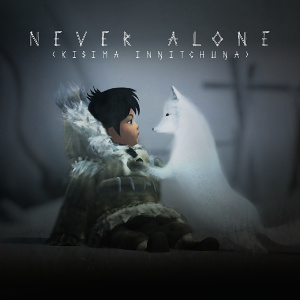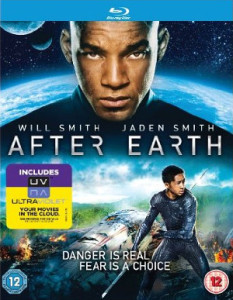
Developer: Upper One Games, E-Line Media
First Release: 18th November, 2014
Version Played: PS4
Length: Short
Links: Game Website
Never Alone (Kisima Ingitchuna) is a side-scrolling platform game, produced in collaboration with the Iñupiat (Alaska Native peoples). When endless blizzards stop her community from hunting, a young girl (Nuna) heads out into the storm to find the source. She’s soon joined by an arctic fox.
Most of the game mechanics will be familiar to players of this type of game. Nuna can move objects, climb ropes and throw a bola. Fox can scrabble up walls. The difference comes in how the mechanics fit into the game. Air currents used to help or hinder jumps aren’t uncommon, but here the gusts of wind are the ever-present blizzard at the centre of the narrative. Moving platforms are common in the genre, but these platforms are in the form of spirits, which Fox calls and can direct. They fit naturally into the game world, rather than seeming like something that wouldn’t be there if it wasn’t needed for the game.
The atmosphere and story of the game are its strong points. It successfully creates the feel of the tundra and beyond, and the artwork used for the spirits is lovely. The story is a re-telling of a traditional story, with additions and changes to expand it for the game. This is reinforced with narration in the Iñupiaq language and cut-scenes reminiscent of scrimshaw art.
The cultural insights are also a great feature. During the game, there are a number of owls. Reaching the owls unlocks a cultural insight, which can be watched at any point. These are mini documentaries with Alaska Native people talking about their lives and culture. The insights explain various aspects of the game, including how the story is different to the original story. There are also quotes from this story on loading screens. So without leaving the game, the player understands how the game story was constructed (a notable change is turning a man into a young girl and her fox), and the people and culture behind it.
There were some aspects of the game controls that were a bit clunky. In single player mode, it would be very useful to be able to tell the other character to stay. For some puzzles, the AI would walk them into dangerous places (they wouldn’t jump to their death or anything, but would stand in the path of moving dangers). It wasn’t game breaking, as the AI could be dealt with by leaving the other character in a different place. But this could be smoothed out in future releases from the developer.
Experienced gamers will likely find the gameplay on the easy side. However, the atmosphere and the cultural insights made it stand out. I loved exploring the world as Nuna and Fox, and would be on board for any of their future adventures.
 First Published: 1st September, 2013
First Published: 1st September, 2013
 ** The review contains some mild spoilers, but not the major twists or ending **
** The review contains some mild spoilers, but not the major twists or ending ** Series: Above World, #1
Series: Above World, #1 Series: Steam-Powered, #1
Series: Steam-Powered, #1